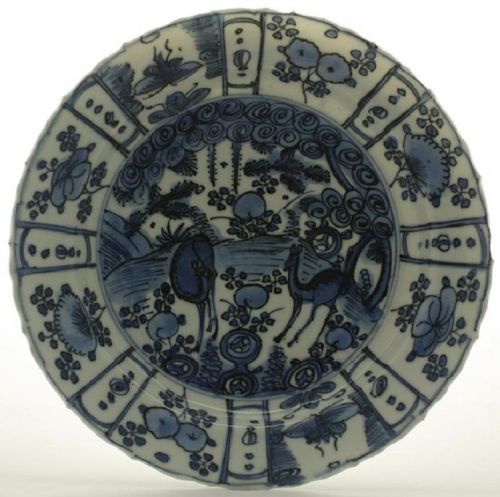
Sold Ceramics - Sold Kraak Porcelain wares 1570-1645 - Dishes - Page 1
Object 201078
Dish
China
1575-1615
Height 35 mm (1.37 inch), diameter of rim 204 mm (8.03 inch), diameter of footring 115 mm (4.53 inch)
Dish on footring, slightly scalloped flat rim, pierced footring. Decorated in underglaze blue with two spotted deer in a landscape with rocks, plants and a pine tree encircled by a double band. On the sides and rim eight large panels filled with flowers and peaches alternating with narrow panels with rows of dots. On the reverse eight broad panels filled with flaming pearls.
According to Rinaldi this dish can be classified as a Border V dish. Border V is characterized by large segments separated by narrow ones. The decoration on the border is less crowded than on other groups. Each large section usually contains a dainty floral or fruit spray or insects, and allows plenty of undecorated space around each design. In the narrow sections there are only dots or a thinly-drawn knotted ribbon. In contrast to the airy border, the central medallion is rather crowded. The underside, following the inside pattern, is divided into large sections with symbols or jewels. and narrow segments with lingzhi. (Rinaldi 1989, pp.88-91)
The central decoration of two deer in a landscape refers to the belief that only deer were capable of finding the divine mushroom of immortality. It fits seamlessly into the popular Chinese iconography of that period, in which a long life is central. (Campen & Eliëns 2014, p.56)
Ostkamp states that A large group of intact objects of Kraak porcelain emerged from the wreck of the Spanish galleon the San Diego, which sank in 1600 off the coast of the Philippines. It is noticeable that alongside Kraak porcelain of an often exceptionally high quality (Fig. 34) there is also much coarse Zhangzhou porcelain among the finds. (Campen & Eliëns 2014, p.52 & p.81, Fig. 34)
A hole has been drilled in the very short footring in order to fit a wire through it - the traditional Dutch way to hang dishes on walls as display pieces. (Rinaldi 1989, p.137)
Condition: A small glaze hairline and two very tiny fleabites to the rim.
References:
Rinaldi 1989, P.137, Pl. 68 & Pl. 72
Campen & Eliëns 2014, p.52, p.56 & Fig. 34
Price: Sold.


 create websites
create websites